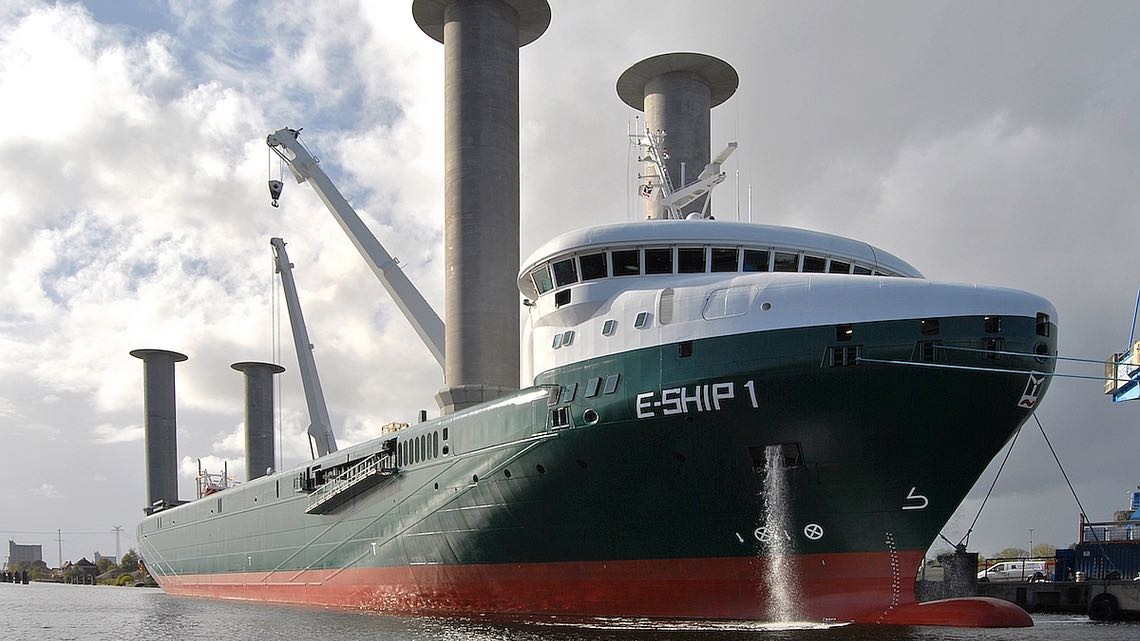Rotor Ships – Flattener Sailing Rotor Vessels
To introduce this type of ship, knowing the “Magnus effect” is essential, but I will deal with the subject in a simplified form, with the aim of intriguing rather than explaining.
Let’s imagine a soccer player hitting the ball with a tip and trying to visualize it travelling its parabola trajectory up to the goalkeeper’s arms. Let alone now the same ball hit with an “effect” kick: the player gives it a more or less accentuated rotation to deflect it from its trajectory and surprise the goalkeeper.
The result comes from the pressure difference between the two faces of the rotating object.
This pressure difference generates a force vector capable, in this case, of moving the ball from its natural trajectory on its way to the goal.
The player knows that, depending on the speed of rotation he gives to the ball, this will have a more or less marked deviation, even if not all players understand that the result obtained is due to the so-called “Magnus effect”.
Based on this principle, German engineer Anton Flettner invented a cylindrical rotor, a new propulsion system successfully used over the years, not only in the aeronautical field. Highly efficient aircraft, naval rudders and thrusters were built with this type of engine.
Today let’s talk briefly about these rotor vessels.
You don’t see many; however, they exist and are now sailing the seas.
The first ship to use this system, built by Flettner in 1924 and equipped with two cylinders 3 meters wide and 15 meters high, used a small engine and wind to generate this force. This system was not considered very efficient, at least compared to conventional propulsion, and it remained abandoned for a long time. However, the idea was still latent until the 1980s, when it was conceived as an aid to the primary propulsion system to reduce fuel costs by progressively increasing.
But how do the rotors work?
Flettner rotors are large cylinders that rise vertically from the ship’s deck, mechanically connected to the propeller, their primary energy source. They function like sails, so their middle name is rotor sails. The wind, hitting the rotating cylinders, generates a perpendicular force that follows the law of the Magnus effect:
A rotating body in a moving fluid generates a force perpendicular to the body’s axis and the fluid’s direction.
Graphically we can see it like this:
When the wind hits the ship from the side, it generates a force that helps the main propeller propel the vessel forward. In order not to create resistance to movement when the ship changes course, it is possible to reverse the direction of rotation of the rotor. By contributing to propulsion, the rotor sails reduce consumption which is their primary purpose.
In the summer of 2010, the E-Ship1 made its first voyage. A cargo ship with a bow deck of 130 meters long and about 13,000 GRT, used for the transport of wind turbines, equipped with bow and stern thruster, two propellers and four Flettner rotors 27 meters high and 4 meters wide.
Powered by two marine diesel engines and, in part, by the rotors, she reaches a maximum speed of 17.5 knots, achieving fuel savings of 10% compared to the exclusive propeller propulsion.
For some companies, these results are worth the investment. So we are witnessing a slow but steady increase in the system in the world fleet.
• In 2015, two rotors were installed on the Ro/Ro Estraden.
• In 2018, a rotor was installed in the bow of the freighter Fehn Pollux.
• In 2018, a rotor was installed on the Viking Grace passenger ship.
• In 2018, four mobile rotors were installed on the 199-meter, 36452 GRT ship Afros.
The peculiarity of the mobile rotors allows the ship to carry out commercial operations more efficiently and then use the rotors in navigation:
Also in 2018, two rotors 30 meters high and 5 meters wide were installed on the Maersk Pelican tanker – in the following video, we can see the installation – as well as many other details of the system:
Each of these ships declares consumption decreased by 10 to 20%, lowering polluting emissions.
Modern technology and materials have reduced costs and optimized performance, making the rotors increasingly lighter and more performing.
The potential for further development exists!
If you meet one of these ships by sea, please let us know and send us a photo! We will publish it with your comment.


